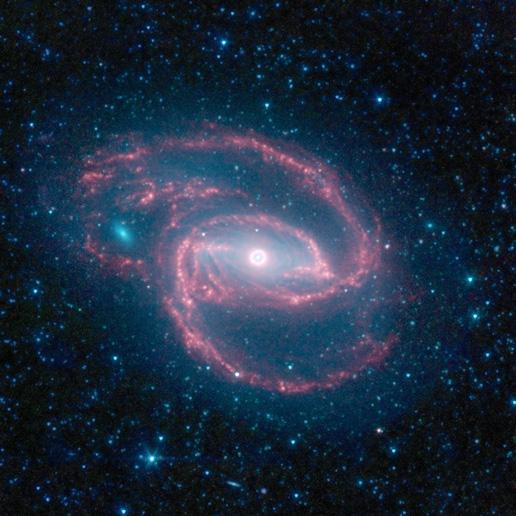Besides God's eye, it turns out that Big Brother's eye continues to watch over us from space. Spitzer photographed galaxies in the final stages of merging, which resembles a slightly made-up eye - please recognize: NGC 1097

The Spitzer Space Telescope, which photographs the sky in the infrared range, captured a celestial monster in the dark - a galaxy that is in the process of merging from several galaxies, with a giant eye-like object at its center.
The galaxy, known as NGC 1097 is located 50 million light years away from us. Its shape is helical (spiral) like our Milky Way and has long, swirling arms of stars. The "eye" in the center of the galaxy is actually a terrible black hole surrounded by a ring of stars. In a color-coded photograph illustrating Spitzer's infrared image, the area around the invisible black hole is blue and the ring of stars is white.
The black hole is huge. It has a mass of about 100 million solar masses and is fueled by gas and dust, as well as random stray stars. The black hole at the center of the Milky Way is dwarfed by comparison, having a mass of only a few million suns.
The fate of this black hole and others like it is an active area of research, says George Helou, deputy director of the Spitzer Science Center and a researcher at the California Institute of Technology in Pasadena. "According to some of the theories, the black hole may relax and eventually enter a dormant state like the one at the center of our galaxy.
The ring around the black hole is buzzing with new star formation. A flow of materials towards the central "pole" of the galaxy causes the ring to shine thanks to those young stars.
"The ring itself is a spectacular object and worth studying due to its high star formation rate," says Kartik Sheth, an astronomer at the Spitzer Science Center. Sheth and Hello are part of the team that made the observation.

7 תגובות
What a cool article
If I'm not mistaken, the closest galaxy to us is the Andromeda galaxy and it's about two million light years away.
Nice picture, thanks
Thanks for the vigilance Alex, fixed.
alexds9, it was easier to check in the attached link, everything is there in the first sentence 🙂
I found, the name of the galaxy is NGC 1097, and it is 50 million light years away from us.
http://galaxywire.net/tag/spitzer/
There is a mistake in the article. According to my test NGC 1907 is an open star cluster 4,500 light years away from us. And even if it's just a mistake in the exact number of NGC, then a distance of 50 light-years from any galaxy is clearly illogical.